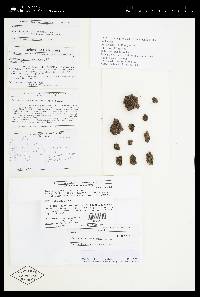
Consortium of Lichen Herbaria
- building a Global Consortium of Bryophytes and Lichens as keystones of cryptobiotic communities -
- Home
- Search
- Images
- Species Checklists
- US States: O-Z >
- US National Parks
- Central America
- South America
- US National Parks
- Southern Subpolar Region
|
|
|
|
Family: Trapeliaceae
|
Nash, T.H., Ryan, B.D., Gries, C., Bungartz, F., (eds.) 2004. Lichen Flora of the Greater Sonoran Desert Region. Vol 2. Thallus: crustose, areolate, dispersed to continuous, dark brown (not olive-gray) areoles: brown, marginate, soon breaking down into isidioid structures surface: brown, wrinkled, fissured, convex Apothecia: scattered when present, initially circular but becoming deformed with age, sessile, c. 0.6 mm in diam. disc: black, +plane to slightly convex margin: black, becoming flexuous and deformed, eventually excluded exciple: brown, K-, C- epihymenium: brown to yellow- or red-brown hymenium: pale brown, c. 100 µm tall, IKI+ blue; paraphyses: slender hypothecium: brown, K-, C- asci: cylindrical-clavate, 8-spored ascospores: hyaline, simple, obtuse-ellipsoid, 10-12(-14) x 6-8 µm Spot tests: thallus (squash) K-, C-, KC-, P- Secondary metabolites: none detected (or two unknowns). Substrate and ecology: on thin soil over granitic boulders or directly on rock or on detritus of Adenostoma World distribution: North America (southern California, Missouri) Sonoran distribution: southern California Notes: Placynthiella knudsenii could be confused with P. oligotropha; however, the proportionally larger spores and thallus composed of areoles that break down to form isidioid structures easily distinguish it. Placynthiella oligotropha also occupies a somewhat different habitat type (humus and lignum) than P. knudsenii. |
Powered by Symbiota















